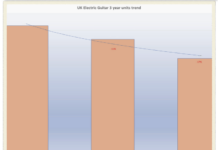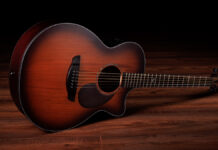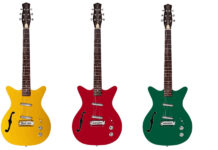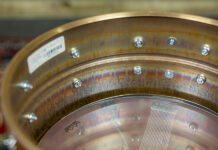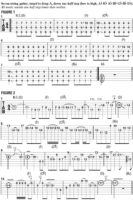
Double Strummed Octaves, and My Solo in “The Price Is Wrong”
If you’ve been following my columns, you’re well aware of the altered tunings I use virtually all of the time. On six-string guitar, my go-to tuning is what I call “drop-C” (low to high, of C G C F A D), which is drop-D down one whole step.
Last month, I broke down the primary licks in the Periphery song “Flatline,” from our latest release, Periphery III: Select Difficulty, which I play on a seven-string guitar tuned to drop-A, down one half step (low to high, Ab Eb Ab Db Gb Bb Eb). I use this same tuning for the focus of this month’s column, which is on the song “The Price Is Wrong,” from the same album.
As is usually the case, I prefer to think of the notes and chords in both of these tunings in a transposing manner, meaning that, if I strum the open bottom three strings of the seven-string in this tuning, I refer to the resultant chord as “A5,” as opposed to its actual concert pitch of Ab5. I find that this mental shortcut facilitates the recognition of, and reference to, various chord forms and riffs.
FIGURE 1 illustrates the primary rhythm part behind the solo. This eight-bar pattern, which repeats, is built from sliding double strummed octaves: I place my index and middle fingers at the same frets on the seventh and fifth strings, along with my pinkie on the third string, two frets higher.
I mute the unused sixth and fourth strings by lightly resting the underside of my fret-hand index finger across the bottom four strings. Doing so enables me to strum across the bottom four strings without inadvertently sounding any unwanted notes on the unfretted strings. I start with the double octave shape at the fifth fret to sound a D octave and then slide it up three frets to F, then down to the fourth fret for C#.
At the end of the figure, I slide the double-octave grip down to the first fret, for Bb. To achieve an aggressive, hard-driving sound, be sure to strum across the strings in a repeating eighth-note down-up pattern throughout. FIGURE 2 presents the complete 16-bar solo, and throughout this passage I employ a lot of quick positional shifts, with finger slides, to create a feeling of uneasiness. In bars 1–8, the scale most closely associated with these lines is D harmonic minor (D E F G A Bb C#), with the inclusion of the flatted fifth, Ab.
As you’ll notice, there are some rather wide stretches with the pinkie necessary to accommodate the inclusion of this interval in the melodic passages. In bar 6, I slide a repetitive shape up the third and first strings, with notes sounding sixths apart. In bar 7, I bring in some fast double pull-offs, as well as a deceptive and unusual rhythmic phrasing.
The phrases in bars 10–16 are built from an interval-based approach, as opposed to a more standard melodic approach, starting with an interval of a seventh but then shifting to the repeated use of sliding sixths. The concept of jumping across to non-adjacent strings is then continued throughout the remainder of the solo.
When performing the many finger slides in this solo, strive for absolute accuracy in terms of landing on the “target note” of each slide, but also start each slide from a random, indeterminate place along the length of the string, in order to recreate the “reckless” sound I was going for.
Source: www.guitarworld.com

